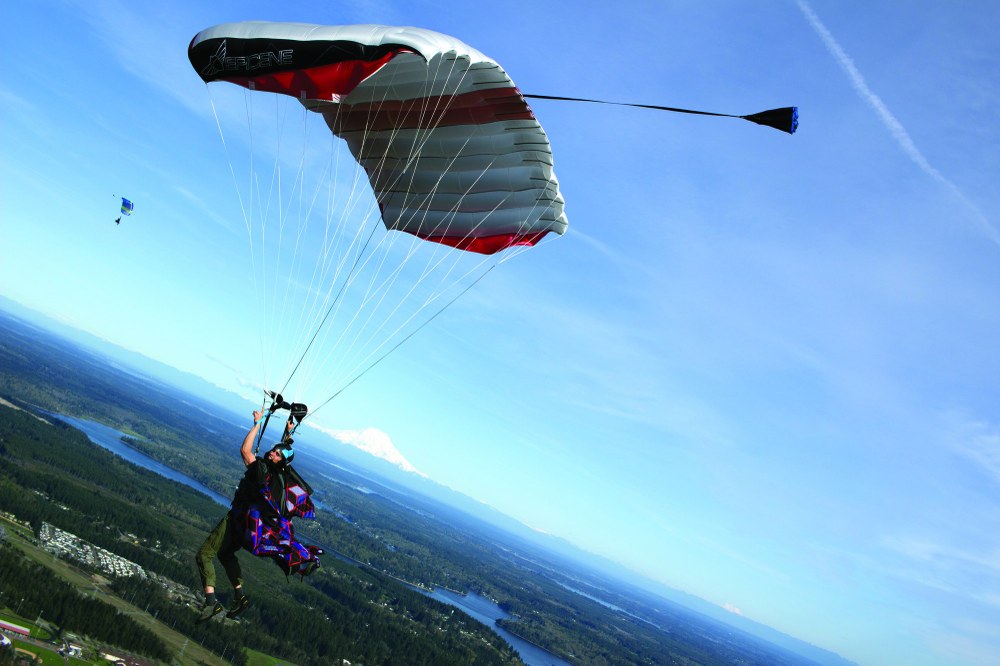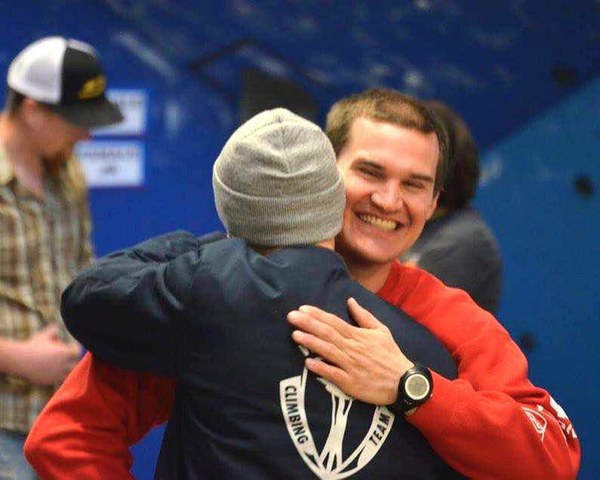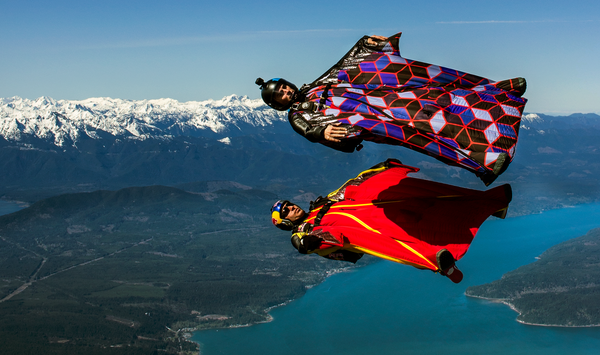
by Rachel Delacour, Skydiver, Skier, Adventurer
On September 7, 2014, just after 5pm, Ross Halverson and his climbing partner were preparing to rappel from the summit of Garfield Mountain. Ross had just finished climbing Infinite Bliss, a twenty-three pitch bolted route ascending the south side of Garfield Mountain. As the late summer sun sunk toward the horizon, it became apparent that both climbers would need to move quickly and efficiently to descend before dark.
Garfield is a large chunk of volcanic rock located just forty miles east of Seattle, offering some of the best-sustained slab climbing in the state. After rigging a rappel with two ropes, Ross began to lower safely from the summit. Then, without explanation, he passed the nearest rappel station, continuing toward another set of anchors below. Before he could apprehend his mistake, the ends of his rope slipped through his belay device, and he fell to his death.
While Ross’ accident was preventable in nature, several experienced climbers die each year as a result of this same mistake. To avoid this incident, sport climbers often tie knots in both ends of the rope prior to rappelling. As a climber, you plan to have more than enough rope-length to lower to the next rappel station, but the knots serve as a quick and easy preventative measure should you overshoot the length of the rope. Not everyone knots the end of their rope each time they rappel, and additional considerations may dissuade climbers from taking this precaution.

Tyson
Tyson Schoene sat across a patio table from me in the glaring sun, his head resting in his hand. Tyson is the head coach and route setter at Vertical World Seattle, where he has worked for the last sixteen years. He considered Ross to be one of his closest companions and most reliable climbing partners. “He made such an impact on everybody that he worked with, and everyone that interacted with him,” Tyson said, a smile spreading across his face. Ross, thirty-one, was an employee at Vertical World, where he quickly became an integral and beloved member of the climbing community. He worked tirelessly to grow Vertical World’s internationally-recognized youth climbing team and had a genuine love for his job.
When they weren’t coaching, Ross and Tyson spent their days suspended in harnesses setting indoor climbing routes. Tyson explained the safety implications of his job: “We double and triple-check everything – all the time. Because when it comes down to it, every single day we are in danger.” For many years, Ross thrived in a world where inattention to detail was not acceptable.
Tyson sighed as he sat back in his chair, “they say he went off the end of his rope… I don’t necessarily disagree with that – but I do find it hard to believe.”
Ross’ accident, and the many others like it, are unsettling and difficult for climbers to comprehend. Why do some of the smartest and most experienced athletes die each year as a result of preventable mistakes?
Matt
Seattle local Matt Gerdes has been involved in air sports for the last sixteen years. He has been skydiving and BASE jumping since 2004, and has completed approximately twelve-hundred BASE jumps without a single injury. He is the co-founder of Squirrel, a rapidly-growing Wingsuit company, and the author of The Great Book of BASE. Despite his lengthy resume, Matt will be the first to remind you that experience does not imply safety. He warns, “With repetition and habituation, comes the risk of complacency.”
Complacency is a controversial term often used to accuse experienced athletes of exhibiting a lack of vigilance. In reality, complacency is a dangerous behavioral tendency which eventually influences everyone who adventures in the outdoors. In order to participate in any sport, we need to experience some level of comfort and confidence. As our level of comfort and familiarity grows, we become less attentive to the inherent danger of our surroundings. When making crucial decisions, we begin to overestimate our abilities and underestimate the associated risk. From the casual backpacker, to the hard-charging backcountry skier, to the calculated climber – understanding and anticipating complacency is crucial to mountain safety and survival.
Matt believes that overconfidence is a primary contributor to the development of complacency. If you successfully participate in an activity frequently enough, it’s easy to develop an inflated sense of your own ability. Overconfidence in our ability makes us more likely to accept unfamiliar or even unknown amounts of risk, something Matt describes as “taking a short-cut.” He believes our desire to accomplish impressive and rewarding things can snuff-out a thorough risk evaluation.
Perhaps the most important thing to understand about complacency is that it can, and will, happen to you. Yes, you. Ask any seasoned adventurer and they will recall at least one moment in their career where they slipped up and are lucky to have survived. I often hear dismissive and critical comments made in response to climbing accidents, “How could they have made such a simple mistake?” Most people don’t believe they’re capable of making these simple mistakes – and studies show they’re not alone.
Many psychologists have illustrated the effects of “illusory superiority,” a cognitive bias allowing people to perceive themselves as being statistically above average. A 1977 study showed a whopping ninety-four percent of professors believed they were above average in comparison to their peers. According to Why We’re All Above Average, most adventurers perceive themselves as far safer and more informed than their peers in the outdoors, which is a deeply flawed assumption. The sooner you recognize that you, too, are susceptible to becoming complacent, the safer you will be.
Dr. Peter J. Boyle is a Professor of Marketing at Central Washington University. He’s spent the last twenty years studying information distortion and overconfidence in varying occupations. His work confirms our suspicions, “all of the research that I’m aware of on overconfidence, suggests that very few of us are not overconfident most of the time.” This overconfidence should be viewed in a medical context, and is distinctly different from exhibiting arrogance. During the decision making process, as people distort available information, confidence in their decision increases. This makes us increasingly susceptible to becoming complacent, “What happens if we think [a task] is easy? We don’t give it due diligence. We don’t put the effort into it that we should.” Complacency allows us to actively ignore or distort valuable information, and negatively impacts our ability to assess our surroundings and abilities.
Tyson says that Ross’ accident has changed the way he views and manages risk in climbing. “The reality is: I want to do this again tomorrow. And I want to do it again next week. No one day is ever worth [the risk] to me, ever.” You can be neurotic about addressing complacency and still slip up. We must use all the tools we have to mitigate this fatal behavioral tendency — to enjoy another day in the mountains.

Rachel’s Suggestions for Avoiding Complacency
Practicing humility and constant self-evaluation will help keep you alive, and we must all work together to get ahead of this dangerous behavioral bias. I suggest you consider these preventative and detective measures when analyzing your own decision-making processes:
Partners – We know almost everyone has a tendency to be overconfident, and Dr. Boyle’s research has shown that we are largely incapable of counteracting our overconfidence, therefore it’s immensely important we choose outdoor adventure partners wisely. Simply put: we need others to hold us accountable and keep us honest. Find partners you trust and respect, and ask for feedback often. If your partner says you’re behaving irrationally, listen to them and act accordingly. An honest friend can be your most reliable resource in the outdoors.
Awareness – Spend time contemplating and planning for your objective. Identify the most risk-prone parts of your adventure, and anticipate mistakes. Matt elaborates, “when I’m standing on an exit point of a wingsuit BASE jump, I’m looking at everything: all the things that could go wrong.” His list of concerns is exhaustive and admittedly gruesome. While this strategy may not apply to all mountain adventures, having an acute awareness of the risks involved in your chosen activity is a healthy way to stay scared and safe.
Gear Checks – One pair of eyes isn’t always enough, and in most outdoor pursuits our equipment is essential to our survival. Every adventurer should get in the habit of asking for routine gear or safety checks before leaving the ground. While the process of performing safety checks may become less formal over time, it should never be overlooked or neglected.
Rachel Delacour was born and raised in the Pacific Northwest. She graduated from The Mountaineers Basic Climbing Course at age sixteen, and has since climbed all of the active volcanoes in Washington, and skied from the summit of many other peaks. In addition to her growing interest in skydiving, Rachel has spent the last few winters pursuing professional big mountain and backcountry skiing.
Add a comment
Log in to add comments.Just a couple comments ;) I've been active in the backcountry since the 1970s and have to add that fatigue and/or high altitude effects is/are probably the main factor(s) in all the accidents or poor judgement decisions I have either experienced directly or witnessed. Neither of these are mentioned in the article...
This is an excellent article! I have long feared complacency and overconfidence within our own Mountaineer courses in the teaching of self-arrest and glissading. We typically teach these skills in easy, slow, and/or soft snow conditions. In real life, we need these skills on harder, steeper snow. Over the course of four decades of climbing and scrambling, I have seen and/or tended to a number of injuries - to trained climbers and scramblers - who did not or could not do a safe self-arrest after a slip, a fall or a glissade. I feel certain that our training is inadequate and gives many, many people an overconfidence in their ability to safely self-arrest.
 Rachel Delacour
Rachel Delacour